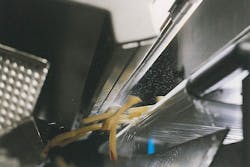Spatially resolved spectroscopy identifies toxic potatoes
A new spectroscopy technique developed by Lien Smeesters in the B-PHOT Brussels Photonics Team at the University of Brussels (Brussels, Belgium), in collaboration with Tomra Sorting Solutions (Asker, Norway), uses a laser sensor and scans peeled potatoes, weeding out food that may cause high levels of the toxic chemical acrylamide.
RELATED ARTICLE: IR spectroscopy speeds E. coli detection
Earlier this year, the Food Standards Agency (FSA) issued warnings about eating over-fried potatoes, burnt toast, and crisps (potato chips) that can contain cancer-causing chemicals such as acrylamide, deeming them a serious health threat to billions of consumers. At present, raw potatoes that produce an excess of the carcinogenic chemical acrylamide cannot be detected in a fast, sensitive, and non-destructive way.
The system works by scanning the 'free falling' food items, such as potatoes, from both the front and back with a laser within a spatially resolved spectroscopy instrument--a non-invasive imaging technique using infrared light. When the laser beam hits a potato, part of the light will be internally scatted during interaction with the tissue. A bad potato produces a deviating internal scattering signal, owing to the high acrylamide precursors, and therefore the system can recognize a 'fingerprint' of the undesirable food.
This unwanted food item is spotted in mid-air as it begins to fall. Selected by the internal processor, the potato is then 'knocked out' of the batch by being blasted with a stream of air and into a reject bin before it hits the conveyor belt below. Smeesters explains, "Not all potatoes result in excessive acrylamide formation during frying. We have sought to spot the undesirable potatoes when they are in their raw, peeled stage. After scanning with laser beams, the good potatoes will emit a different light signal than the unsuited ones leading to an unambiguous detection."
Having filed a patent describing the use of this detection method, the laser scanner will be integrated into one of Tomra's industrial in-line sorting machines, detecting and discarding food items that may contain excessive acrylamide precursors. Several tons of products could be examined per hour to look for these carcinogenic compounds without using dyes or chemical additives, and without damaging or even touching the food.
The driving force behind the detection method is Lien Smeesters, 28, a post-doctoral researcher at the University in Brussels in the B-PHOT Brussels Photonics Team and recent winner of the Student Innovation Award at the Photonics Public Private Partnership Annual Meeting.
Smeesters' development comes at a time where tougher acrylamide regulation has been called for by the sustainability group Changing Markets Foundation as well as the recent Go for Gold campaign by the Food Standards Agency, helping people understand how to minimize exposure to acrylamide when cooking at home.
Smeesters adds, "Although we are a long way off this yet, the miniaturization of the technology would enable a compact potato quality test tool in your home. A hand-held device indicating whether a potato would be unsuited for frying could reduce our exposure to acrylamide … One day we envisage a world where toxic French fries will be a thing of the past!"
SOURCE: Photonics PPP press release and B-PHOT; http://www.b-phot.org/www/Photonics-based-technologies-keep-French-fries-on-the-menu

Gail Overton | Senior Editor (2004-2020)
Gail has more than 30 years of engineering, marketing, product management, and editorial experience in the photonics and optical communications industry. Before joining the staff at Laser Focus World in 2004, she held many product management and product marketing roles in the fiber-optics industry, most notably at Hughes (El Segundo, CA), GTE Labs (Waltham, MA), Corning (Corning, NY), Photon Kinetics (Beaverton, OR), and Newport Corporation (Irvine, CA). During her marketing career, Gail published articles in WDM Solutions and Sensors magazine and traveled internationally to conduct product and sales training. Gail received her BS degree in physics, with an emphasis in optics, from San Diego State University in San Diego, CA in May 1986.
